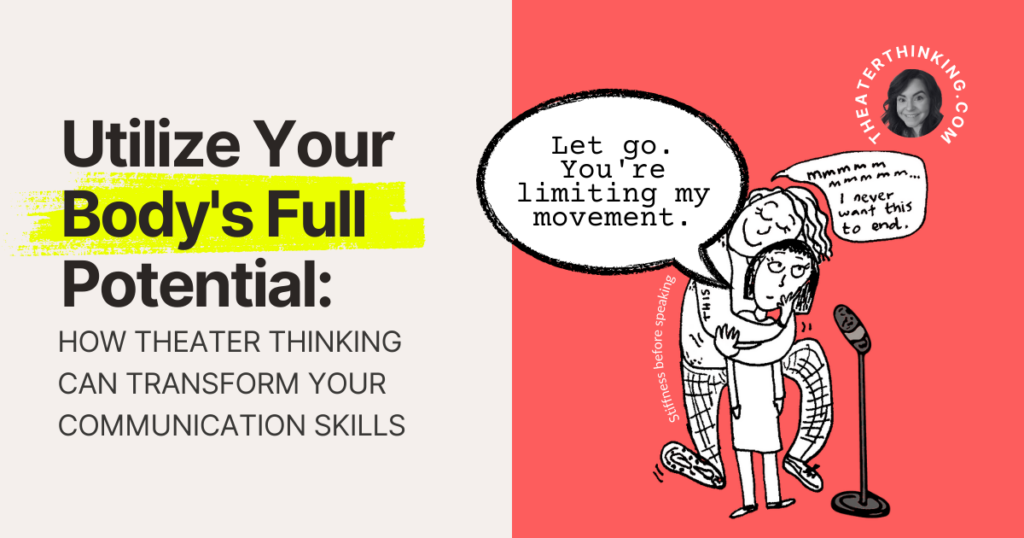Utilize Your Body’s Full Potential: How Theater Thinking Can Transform Your Communication Skills

As a speaker, your body is one of your most powerful tools for conveying your message. Many speakers may have mastered the art of the steeple hands or the perfect posture, but the true potential of their physical body remains untapped. With a theater background, I’ve come to understand the incredible impact your body can have on your communication skills. In this blog, we’ll explore the concept of theater thinking and how it can help you transform your body into a dynamic and captivating tool for effective communication.
Rely on Physical Presence to Engage Your Audience
The world of theater arts has a lot to teach us about using our bodies effectively to communicate. Actors on stage constantly rely on their physical presence to bring characters to life and engage their audience. By adopting Theater Thinking, you can leverage these transferable skills to enhance your personal and professional communication.
Here’s a breakdown of the key aspects of Theater Thinking and how they apply to use your body for dynamic communication:
1. Stage Presence: Commanding attention on stage is a crucial skill for actors, and the same principle applies to speakers. By developing a strong stage presence, you can capture your audience’s attention and maintain their interest throughout your presentation.
2. Physical Expression: In theater, actors use their bodies to express emotions, thoughts, and intentions. As a speaker, you can harness the power of physical expression to reinforce your message and make it more memorable.
3. Nonverbal Communication: Research indicates that nonverbal cues play a crucial role in our communication, significantly impacting how our messages are perceived and understood. In fact, Patterson (2011) highlights the power of nonverbal communication in social interactions, demonstrating its importance in effectively conveying our thoughts and emotions. By mastering nonverbal communication and body language, you can ensure that your physical expressions support and enhance your message, leading to more impactful and memorable communication.
4. Fluidity and Adaptability: Theater actors must be adaptable and able to adjust their movements and expressions to suit the scene. As a speaker, you can cultivate fluidity and adaptability to respond effectively to your audience’s reactions and create a more engaging experience.
My Approach to Teaching Body Dynamics:
Drawing from my theater background, my approach to teaching body dynamics focuses on helping speakers unlock the full potential of their physical expression. Here’s an overview of my unique teaching method:
- Physical Warm-Up Exercises: Just like actors preparing for a performance, speakers should warm up their bodies before a presentation. We’ll explore various warm-up exercises to increase body awareness, flexibility, and control.
- Movement Exploration: We’ll dive into different movement techniques, inspired by theater arts, to help you discover new ways of using your body to convey your message and engage your audience.
- Emotional Expression: Emotions play a crucial role in communication, and we’ll work on connecting your body language with your emotional state to create a more authentic and impactful message.
- Personalized Coaching: Every speaker is unique, and I’ll provide personalized coaching to help you develop your own dynamic body language style that suits your personality and message.
By embracing theater thinking and applying the lessons from the stage to your body language, you can unlock a whole new level of dynamic communication. Your body is a powerful tool, and when used effectively, it can captivate your audience, strengthen your message, and leave a lasting impression. So, step into the spotlight and let your body take center stage in your communication journey!
Action Steps: Practical Ways to Enhance Your Body Language
Now that you’re aware of the power of body language in communication, it’s time to take some practical action steps to start implementing improvements. Here are some useful tips to help you refine your body language and make a lasting impact on your audience:
- Observe and learn from experts: Watch videos of renowned public speakers or theater performers and pay close attention to their body language. Notice how they use gestures, facial expressions, and body posture to emphasize their points and engage their audience.
- Experiment with movement: Take some time to experiment with your movements in different ways, such as pacing, hand gestures, or facial expressions. Don’t worry about being perfect or looking a certain way – focus on exploring what feels natural and effective for you.
- Record yourself: Record a video of yourself presenting, then watch the playback and analyze your body language. Identify areas where you can improve and work on incorporating more effective nonverbal cues.
- Seek feedback: Ask a trusted friend or colleague to observe your presentation and provide feedback on your body language. Use their insights to make adjustments and continue refining your nonverbal communication skills.
- Take a theater or improv class: Enrolling in a theater or improvisation class can help you become more comfortable with using your body as a communication tool. These classes will teach you techniques to be more expressive, spontaneous, and adaptable in your communication style.
- Be mindful of cultural differences: When communicating with people from different cultural backgrounds, be aware that some gestures and body language cues might have different meanings. Research and adapt your body language to ensure you’re conveying the intended message in a culturally sensitive manner.
By incorporating these action steps into your routine, you’ll be well on your way to mastering the art of body language and enhancing your communication skills through the power of Theater Thinking. Remember, practice makes perfect – so stay dedicated and watch as your body becomes a dynamic and impactful tool in conveying your message.